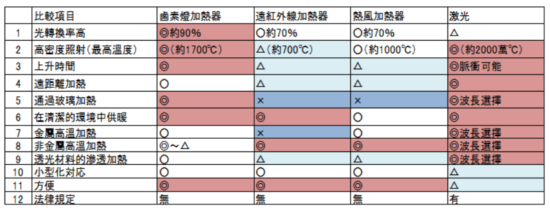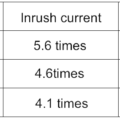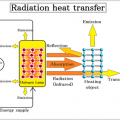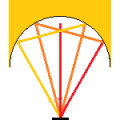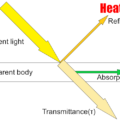INDEX
鹵素燈加熱器是通過鹵素燈將供應的電力轉換成光線,通過集光鏡將光線集中,並在高溫下加熱的加熱器。
鹵素燈的大部分波長分佈在 500nm~2500nm 範圍內的可見到近紅外區域。
在近紅外區,峰值波長約為900nm~1000nm。
因此,被加熱物體的吸收率越接近近紅外區域的光譜分佈,加熱效率就越好。
鹵素燈加熱器的特點
(1) 高能量轉換率
電能換成光能的比例為90%以上。用電加熱時,加熱效率非常好。
鹵素燈將鎢絲傳輸的電轉化為光,並將其轉化為光。
鹵素燈加熱器使用燈發出的光(可見光到近紅外區域)。
由於蒸發的金屬顆粒被鹵素氣體還原,壽命延長,可用於工業用途。
鹵素燈的轉換效率對可見光約為10%,對紅外光約為80%,對極少量的紫外光。
可見光和紫外線也是電磁波,因此它們具有加熱物體的能量。
對所有電磁波的轉換效率在90%,是一種非常高效的加熱方式。
對被加熱物體的集光效率取決於集光鏡的曲率。
集光鏡焦距越短,集光鏡利用率越高,聚焦效率越好。
照射的電磁波被熱量吸收和替代,但吸收量=溫度會根據被加熱物體的吸收率、顏色和表面狀況而發生很大變化。
因此,了解構成光(電磁波) 90% 的紅外線的吸收率很重要。
(2)加熱器的上升時間很快。
由於加熱器立即啟動,因此節省了空閒時間並且經濟。
在我們的頂級設備HPH160的情況下,大約需要12秒才能達到最高溫度的70%輸出。
(3)電壓可以隨時變化,適合PID控制。
如果要根據加熱環境改變溫度,只需改變鹵素燈加熱器的電壓即可控制溫度。
在額定電壓以下使用時,可以調整壽命。
(4) 可透過玻璃加熱,可用於無塵室和真空室。
由於燈體由石英玻璃製成,因此可以隔著玻璃使用。
但是,在無塵室使用時,鹵素燈加熱器必須設置為“無塵室規格”。
(5)集光鏡發出的光可以集中。
根據鹵素燈加熱器的類型,可以進行集中加熱,例如點/循環加熱和線/表面加熱。
(6) 可以進行廣泛的加熱,從金屬加熱到非金屬加熱。
鹵素燈加熱器適用於近紅外區域的加熱,可以在廣泛的領域使用和加熱。
(7) 粘合劑和油漆等半透明材料可以加熱內部和表面。
(8) 比其他加熱方式更安全。
萬一出現故障,加熱器溫度迅速下降,因此可以降低被加熱物體著火的風險。
由於氙燈還包括紫外線區域的光線照射,因此不適合用肉眼檢查光線。
此外,根據燈泡的種類,啟動時會瞬間使用約 30,000V 的高壓,因此在使用時必須小心。
處理激光有嚴格的標準,安全標準比其他加熱方法高出幾個數量級。
根據分類,可能會對眼睛和皮膚造成嚴重傷害。
下表是鹵素燈加熱器與其他加熱方法的比較表。
*鹵素燈的光的波長帶為0.4-2.5μm區域,
(從可見光到近紅外輻射區),其中假設大約1μm是峰。
*半透明體(皮膚,油漆和粘合劑等)相對進入內部,並從內部加熱。
*對金屬的吸收率比遠紅外光好,得到非金屬材料之間的巨大差異也不錯。
 HEAT-TECH 最佳技術網店
HEAT-TECH 最佳技術網店 


